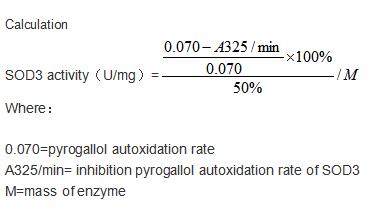Active Superoxide Dismutase 3, Extracellular (SOD3)
SOD-3; EC-SOD; Extracellular Superoxide Dismutase Cu-Zn
- Product No.APA117Rb01
- Organism SpeciesOryctolagus cuniculus (Rabbit) Same name, Different species.
- Buffer FormulationPBS, pH7.4, containing 0.01% SKL, 5% Trehalose.
- TraitsFreeze-dried powder
- Purity> 90%
- Isoelectric Point5.9
- ApplicationsCell culture; Activity Assays.
- Download Instruction Manual
- UOM 10µg50µg 200µg 1mg 5mg
-
FOB
US$ 282
For more details, please contact local distributors!US$ 704
For more details, please contact local distributors! US$ 1408
For more details, please contact local distributors! US$ 4224
For more details, please contact local distributors! US$ 10560
For more details, please contact local distributors!
ACTIVITY TEST of the Active Superoxide Dismutase 3, Extracellular (SOD3)

Extracellular superoxide dismutase [Cu-Zn] is an enzyme that in humans is encoded by the SOD3 gene. This gene encodes a member of the superoxide dismutase (SOD) protein family. SODs are antioxidant enzymes that catalyze the dismutation of two superoxide radicals into hydrogen peroxide and oxygen. Acroding to the report, in a weakly alkaline buffer solution (pH=8.2) with N-tris(hydroxymethyl)amino methane-HCL, pyrogallol can occur autoxidation in the air, then SOD can inhibit this reaction. Thus, we use this way to measued the activity of recombinant rabbit SOD3. The reaction was performed in adding 8 μl 5 mmol/L pyrogallol to 200 μl 50mmol/L Tris-HCl, rapidly mixing at 25 ℃, then read at 325 nm (using 50mmol/L Tris-HCl as blank control) in kinetic mode for 3 minutes using a microplate reader controlling the pyrogallol autoxidation rate at 0.70 OD/min. Different concentrations of recombinant rabbit SOD3 were added into 200 μl 50 mmol/L Tris-HCl, incubated for 20 min at 25 ℃, then adding 8 μl 5 mmol/L pyrogallol to each well, rapidly mixing and read at 325 nm in kinetic mode for 3 minutes. Under these conditions, the enzyme amount of 50% inhibition of pyrogallol autooxidation per minute is defined as a unit. The specific activity of recombinant rabbit SOD3 is 133.9 U/mg.
USAGE of the Active Superoxide Dismutase 3, Extracellular (SOD3)
Reconstitute in 10mM PBS (pH7.4) to a concentration of 0.1-1.0 mg/mL. Do not vortex.
STORAGE of the Active Superoxide Dismutase 3, Extracellular (SOD3)
Avoid repeated freeze/thaw cycles. Store at 2-8°C for one month. Aliquot and store at -80°C for 12 months.
STABILITY of the Active Superoxide Dismutase 3, Extracellular (SOD3)
The thermal stability is described by the loss rate. The loss rate was determined by accelerated thermal degradation test, that is, incubate the protein at 37°C for 48h, and no obvious degradation and precipitation were observed. The loss rate is less than 5% within the expiration date under appropriate storage condition.
INCREMENT SERVICES
BCA Protein Quantification Kit
Molecular Mass Marker for Protein
Monoclonal Antibody Customized Service
Polyclonal Antibody Customized Service
Protein Activity Test Experiment Service
Electrophoretic Mobility Shift Assay (EMSA) Experiment Service
Buffer
Lentivirus Packaging Experiment Service
Adenovirus Packaging Experiment Service
Real Time PCR Experimental Service
Spike RBD Protein (S-RBD)
Protein G
Protein A
Related products
| Catalog No. | Organism species: Oryctolagus cuniculus (Rabbit) | Applications (RESEARCH USE ONLY!) |
| APA117Rb01 | Active Superoxide Dismutase 3, Extracellular (SOD3) | Cell culture; Activity Assays. |
| RPA117Rb01 | Recombinant Superoxide Dismutase 3, Extracellular (SOD3) | Positive Control; Immunogen; SDS-PAGE; WB. |
| PAA117Rb51 | Polyclonal Antibody to Superoxide Dismutase 3, Extracellular (SOD3) | WB; IHC; ICC; IP. |
| PAA117Rb01 | Polyclonal Antibody to Superoxide Dismutase 3, Extracellular (SOD3) | WB; IHC; ICC; IP. |
| MAA117Rb21 | Monoclonal Antibody to Superoxide Dismutase 3, Extracellular (SOD3) | WB; IHC; ICC; IP. |
| SEA117Rb | ELISA Kit for Superoxide Dismutase 3, Extracellular (SOD3) | Enzyme-linked immunosorbent assay for Antigen Detection. |
| LMA117Rb | Multiplex Assay Kit for Superoxide Dismutase 3, Extracellular (SOD3) ,etc. by FLIA (Flow Luminescence Immunoassay) | FLIA Kit for Antigen Detection. |

